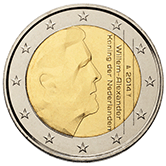
Dutch euro coins currently use two designs by Erwin Olaf, both of which feature a portrait of King Willem-Alexander of the Netherlands. The new designs began circulating in 2014. Dutch Euro coins minted from 1999 to 2013 feature a portrait of Queen Beatrix designed by Bruno Ninaber van Eyben. All coins share the 12 stars of the EU and the year of imprint in their design.

Juliana was Queen of the Netherlands from 1948 until her abdication in 1980.

Wilhelmina was Queen of the Netherlands from 1890 until her abdication in 1948. She reigned for nearly 58 years, making her the longest-reigning monarch in Dutch history, as well as the longest-reigning female monarch outside the United Kingdom. Her reign saw World War I, the Dutch economic crisis of 1933 and World War II.

The krone is the official currency of Denmark, Greenland, and the Faroe Islands, introduced on 1 January 1875. Both the ISO code "DKK" and currency sign "kr." are in common use; the former precedes the value, the latter in some contexts follows it. The currency is sometimes referred to as the Danish crown in English, since krone literally means crown. Krone coins have been minted in Denmark since the 17th century.

The Peace Palace is an international law administrative building in The Hague, the Netherlands. It houses the International Court of Justice, the Permanent Court of Arbitration (PCA), The Hague Academy of International Law and the Peace Palace Library.
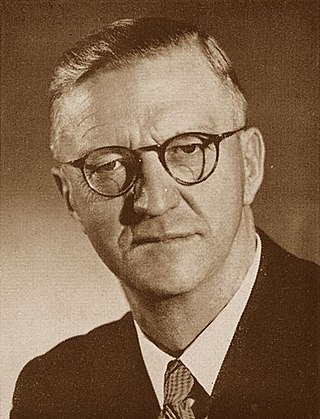
Charles Robberts Swart, nicknamed "Blackie", was a South African politician who served as the last governor-general of the Union of South Africa from 1959 to 1961 and the first state president of the Republic of South Africa from 1961 to 1967.

Huis ten Bosch is a royal palace in The Hague, Netherlands. It is one of three official residences of the Dutch monarch; the two others being the Noordeinde Palace in The Hague and the Royal Palace of Amsterdam.

JonkheerDirk Jan de Geer was a Dutch politician of the Christian Historical Union who served as Prime Minister of the Netherlands from 8 March 1926 until 10 August 1929 and from 10 August 1939 until 3 September 1940.
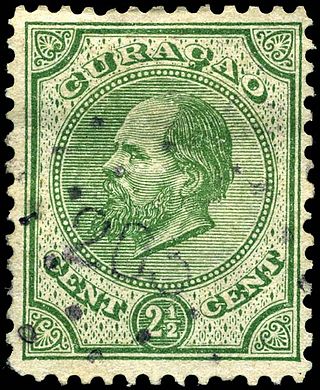
This is a survey of the postage stamps and postal history of the postal areas Netherlands Antilles as well as its predecessor Curaçao. The area consisted of the islands Bonaire, Saba and Sint Eustatius as well as Sint Maarten, Curaçao and Aruba.

The Home of Franklin D. Roosevelt National Historic Site preserves the Springwood estate in Hyde Park, New York, United States. Springwood was the birthplace, lifelong home, and burial place of the 32nd president of the United States, Franklin D. Roosevelt. Eleanor Roosevelt is buried alongside him. The National Historic Site was established in 1945.
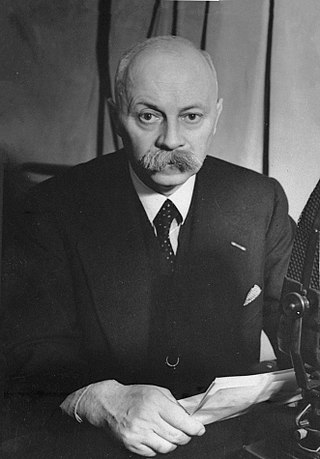
Pieter Sjoerds Gerbrandy was a Dutch politician and jurist who served as Prime Minister of the Netherlands from 3 September 1940 until 25 June 1945. He oversaw the government-in-exile based in London under Queen Wilhelmina during the German occupation of the Netherlands. He was a member of the Anti-Revolutionary Party (ARP).
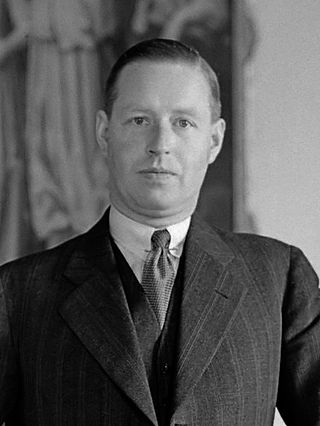
JonkheerAlidius Warmoldus Lambertus Tjarda van Starkenborgh Stachouwer was a Dutch nobleman and statesman, primarily noted for being the last colonial Governor-General of the Dutch East Indies, now Indonesia. He was taken captive after accepting Japan's demands for an unconditional surrender of the islands on 9 March 1942.
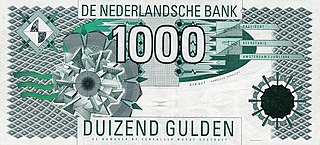
The guilder or florin was the currency of the Netherlands from 1434 until 2002, when it was replaced by the euro.
The coins of Canada are produced by the Royal Canadian Mint and denominated in Canadian dollars ($) and the subunit of dollars, cents (¢). An effigy of the reigning monarch always appears on the obverse of all coins. There are standard images which appear on the reverse, but there are also commemorative and numismatic issues with different images on the reverse.

The Dutch 1 guilder coin struck under the reign of Queen Wilhelmina was a unit of currency in the Netherlands.
The One guilder coin was a coin struck in the Kingdom of the Netherlands between 1818 and 2001. It remained in circulation until 2002 when the guilder currency was replaced by the euro. No guilder coins were minted in the German occupation of the Netherlands in World War II.

Johannes Theodorus Furstner was a Dutch naval officer and politician. Reaching the rank of lieutenant admiral, he served as Minister of the Navy during World War II in the Second Gerbrandy cabinet.

The First Gerbrandy cabinet, also called the Second London cabinet was the executive branch of the Dutch government-in-exile from 3 September 1940 until 27 July 1941. The War cabinet was formed by the christian-democratic Roman Catholic State Party (RKSP), Anti-Revolutionary Party (ARP) and Christian Historical Union (CHU), the social-democratic Social Democratic Workers' Party (SDAP), the social-liberal Free-thinking Democratic League (VBD) and the conservative-liberal Liberal State Party (LSP) after the resignation of the previous Cabinet De Geer II. The national unity government (War cabinet) was the second of four war cabinets of the government-in-exile in London during World War II.

Jacobs Pier Pander was a Dutch sculptor and designer of medals.
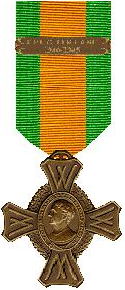
The War Commemorative Cross is a military award of the Netherlands. The medal was established to commemorate service to the Kingdom of the Netherlands during World War II. The medal was established on 16 March 1944 by royal decree of Queen Wilhelmina.






















